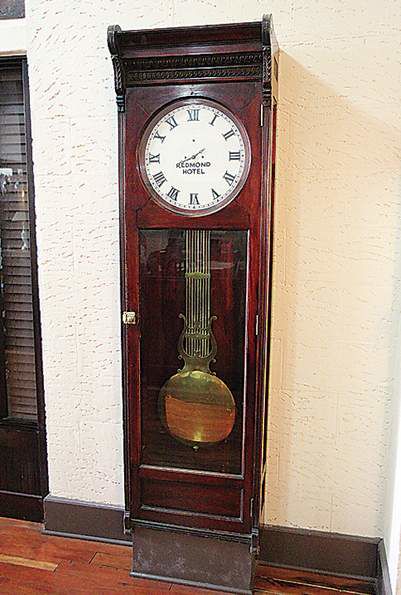Hopes for historic Redmond Hotel
Published 4:00 am Friday, December 14, 2012

- An original grandfather clock sits in the Redmond Hotel. The hotel, built in 1928 as a replacement for the original that was destroyed in a fire, is for sale for $2.7 million.
As the largest building in downtown Redmond, the 84-year-old Redmond Hotel is an iconic structure. But now the city is looking at whether a renovated, fully utilized hotel could become a catalyst for investment in the urban core.
“Downtown lost so much business when the hotel shut down and the highway bypass opened up,” said B.J. Gretler, a former Redmond Hotel owner who currently owns several downtown buildings. “We’re just now starting to find ourselves again. But a hotel is a must downtown, it’s the only ‘destination’ down there.”
Trending
Mindful of the role the hotel plays in its up-and-coming historic district, the city of Redmond recently commissioned a study to evaluate why efforts to make the hotel a viable investment have not been successful over the years and what it would take to make that happen.
The “New” Redmond Hotel, as it says on the vintage neon sign out front, was built in 1928 after its predecessor, a two-story wooden structure, burned in a fire that took several downtown businesses with it — including the nearby Oregon Hotel.
The Redmond Hotel was hailed upon construction as a premier destination hotel, with 43,000 square feet of guest rooms, a restaurant, library, banquet/dance hall and grand lobby. Three decades later, the hotel was making the transition into more of a residential building, with one-bedroom and studio apartments added to the mix of overnight guest rooms. By the late-1970s, the building was nearly derelict.
“I hired a bodyguard to come with me when I went inside the hotel,” said Gretler, who purchased the hotel in 1979. “It was my first business venture and it was so much work.”
She had to find alternative housing for some of the residents, many on Social Security or public assistance, then get to work ripping out all the deteriorated flooring, furnishings and plumbing.
Renovations have been a common occurrence at the hotel, with major overhauls in the late 1950s, during Gretler’s tenure, then again during the late 1980s and 1990s. The most recent investments occurred after 2004 when Brad Evert and his partners bought the hotel and closed the rooms upstairs to allow for remodeling and upgrades.
Trending
With the exception of a handful of rooms leased as office space, the hotel never reopened. It is currently on the market, with a $2.7 million price tag.
“When we bought it we were uncertain about what to do with the upstairs,’” says Evert. “We spent a lot on renovations, trying to bring back the history by stripping sheetrock off the brick, exposing the 14-foot ceilings and removing fluorescent lights.”
They marched through the hotel spaces one at a time, making upgrades and waiting for the economy to improve.
“If this same building were in the Pearl District (in Portland) or Bend it would be a big hit,” says Evert. “Lots of people have tried to make a go of this hotel, but the rehab of downtown Redmond has been slower.”
It’s the chicken-or-egg question of developing one site to promote development in other sites that city officials are contemplating.
“In the past, Redmond has deployed urban renewal funds for infrastructure like roads but the main reason for urban renewal is to prompt private investment,” said Heather Richards, Redmond community development director. “We looked back (at infrastructure investments) and asked ‘was it successful?’ But it seemed we still had plenty of blight downtown.”
When the city’s urban renewal district was extended last year, the hotel was identified as a potential target for up to $2 million in public funds, given its importance in the downtown economy.
“The big question is: What are the barriers to investment downtown?” said Richards. “What we discovered is that with the hotel being such a large piece of downtown and mostly vacant, it was actually bringing down the amount of investment in the area.”
A partnership between public and private entities can work several ways, according to Richards. Sometimes urban renewal agencies purchase land and seek investors who will develop it to predetermined specifications with the land being the public’s investment. Or public funds can be spent on certain aspects of the development, usually those with specific public benefits.
“For example, limited parking at the hotel hasn’t been penciling out for investors who might need to buy more land (for more parking) so our piece of the partnership could conceivably be that part, a parking facility that would benefit the hotel and the public downtown,” she said.
Parking for the hotel over the years changed as its focus changed. When Gretler owned the hotel, there was still hotel-owned parking directly behind the building. But when Evert purchased the hotel in 2004, there were only a couple of dozen spaces there, all leased from a nearby business. He and his partners purchased a half-block at Forest and Seventh Street for additional parking, but it is not adjacent to any part of the hotel.
The consultant’s study examined a handful of other historic hotels in Oregon to see how the market was doing — including the Geiser Grand Hotel in Baker and Hotel Elliott in Astoria — and found most were holding up well in the down economy.
The study was not limited to the building’s use as hotel, rather it looked at three scenarios for development: apartments, office space and lodging. Due to Redmond’s overabundance of office space, and its apartment-dwelling population of mostly young families, a boutique historic hotel was determined to be the most viable route to success, both short and long-term.
The amount of renovation needed to attract the specialty hotel customer is substantial, estimated at $6.3 million, according to a study by SERA Architects. Yet Redmond’s inventory of mostly mid-level hotels means a niche market for a historic hotel.
The hotel’s listing on the National Register of Historic Landmarks would prove a boon to potential developers, according to the study, making it eligible for tax credits worth up to 20 percent of project costs. But either way, public investment would be required to get any redevelopment off the ground, the study says.
Originally, Redmond’s Urban Renewal Agency was not set to examine the potential redevelopment of the hotel for a few years, said Richards, but a proposal brought forward made them realize they needed “a decision-making filter to review the viability of any project.”
“This might be the right time for the city to get involved because the hotel is on the market or we could wait and see what the market will bear,” said Richards. “We’re very aware of being a good steward of public funds and any project must be sustainable in future markets.”
The Downtown Urban Renewal Advisory Committee has formed a subcommittee to examine the report and work with city staff to determine the best next steps, which it will bring to the main advisory committee as a recommendation sometime in the next few months. After that, the Redmond City Council will consider the matter.
1928- New Redmond Hotel opens
1959- Extensive renovations undertaken
1979- Purchased by B.J. Gretler, remodeled again
1986- Hotel sold for $450,00
2004- Overnight rooms closed
2007- Redmond sets requirements that no building near hotel is any taller than its 60 feet








